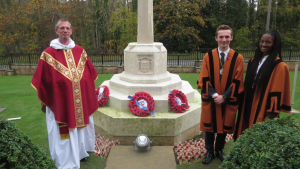 As the nation remembered and honoured those who sacrificed themselves to secure and protect the UK’s freedom this Remembrance Sunday (8th November 2015), pupils and staff at King Edward’s Witley hosted their own traditional Act of Remembrance at the War Memorial at the front of the School on Wednesday 11th November, Armistice Day.
As the nation remembered and honoured those who sacrificed themselves to secure and protect the UK’s freedom this Remembrance Sunday (8th November 2015), pupils and staff at King Edward’s Witley hosted their own traditional Act of Remembrance at the War Memorial at the front of the School on Wednesday 11th November, Armistice Day.
The names of the 92 pupils and 2 ex-staff who died during, or as a result of, World War One were read out followed by the 48 who died on active service in World War Two. As the Roll was read out pupils planted crosses with the names of each of the fallen on them around the War Memorial. This was followed by the laying of the wreaths, the School choir singing the anthem “For the Fallen”, the playing of the Last Post and a two-minute silence before the whole School progressed to the School chapel for a Sung Eucharist.
This Remembrance Sunday was particularly poignant, following the recent restoration of the Great War memorial, which was originally commissioned by the School’s alumni (now known as the Old Witleians or Old Wits). The war memorial carries the inscription ‘Greater love hath no man than this that a man lay down his life for his friends’ and the actual names of those lost in both World Wars are listed in a Book of Remembrance in the School’s chapel. Wreaths were laid by representatives of the Old Witleians’ Association and Bridewell Royal Hospital Foundation and, in a special commemoration this year, by Lt. Cmdr. Bernard Corrie R.N. (rtd) and Mr David Parker, pupils at King Edward’s Witley in the late 1940s and both former servicemen.
The School’s service encouraged participants to pay their respects and take time to remember everyone who perished during or because of the war but in particular, thoughts dwelled on at least 94 former pupils and staff who served and died in World War One, underpinning the sense of duty and service of Witleians through the ages.
In the run up to the service, considerable research had been undertaken by the School’s archivist, Mrs Marilyn Wilkes, to find out more about the names listed in the Book of Remembrance. Mrs Wilkes, a former history teacher and Housemistress at King Edward’s Witley, worked through the archives to establish the life stories behind the former pupils who fought for King and country and paid the ultimate price.
Some of the remarkable accounts serve as clear reminders of the origins of King Edward’s Witley, as a School which retained close links with the City, providing a place for less privileged children to enable them to gain a good education and become useful citizens:
Examples include:
Edmund Henry Quarterman – Lance Corporal 24th Bn. Rifle Brigade
Edmund was an orphan who was in the care of his aunt when he joined the School in 1883. After he left in 1884 he worked for what was then known as the GPO – the Post Office – before joining the army which he left before 1901. When war broke out in 1914, Edmund once again volunteered his services and was posted to India where he served for two years. In January 1918, he died and was buried in Wimbledon Cemetery (Gap Road), having contracted consumption during service.
The bronze Memorial Plaque (issued to next of kin of all British and Empire service personnel who were killed as a result of the war, commonly known as the Dead Man’s Penny) was issued to Edmund’s family to honor his death and is currently held by Edmund’s grandson in Australia.
William Bowman Stanfield – Lieutenant 1st Bn. Northampton Regiment
William had no father and came from Rotherhithe to join the School in 1899, staying for nearly nine years first as a scholar and then progressing to become a Student Teacher. ‘Doggie’ as he was nicknamed was an all round sportsman, representing the School for many years in the cricket and football teams, as well as being a member of the ‘special class’ in the gymnasium and proving himself as an excellent cross country runner. As a Student Teacher he was popular amongst the boys and his colleagues. Initially commissioned to the 3rd Northants Regt, William then proceeded to France where he was attached to the 1st Bn, taking part in the last great advance. Fearless throughout, Williams died as a result of wounds received on the battle field.
Alan Baird Handyside (Cullerne) MC, Second Lieutenant 7th Bn. Queen’s Own Royal West Kent Regiment
Alan was orphaned when he joined the School in 1903 although he was subsequently adopted by his guardians Mr and Mrs Cullerne of Guildford. At School he was known as Handyside and his obituary reads ‘no boy ever left KES who had more affection for School than Alan’. At the outbreak of war, he was stationed in Buenos Aires in South America but he soon came home and offered his services to his Country. Alan was killed in action, when his regiment were engaged in the final stages of the war in Northern France. He was awarded the Military Cross just before his death ‘for conspicuous gallantry and enterprise’.
A full list of the Old Wits who died and their biographies can be found at http://www.kesw.org/images/stories/downloads/OWs/in-memoriam/ww1_names.pdf